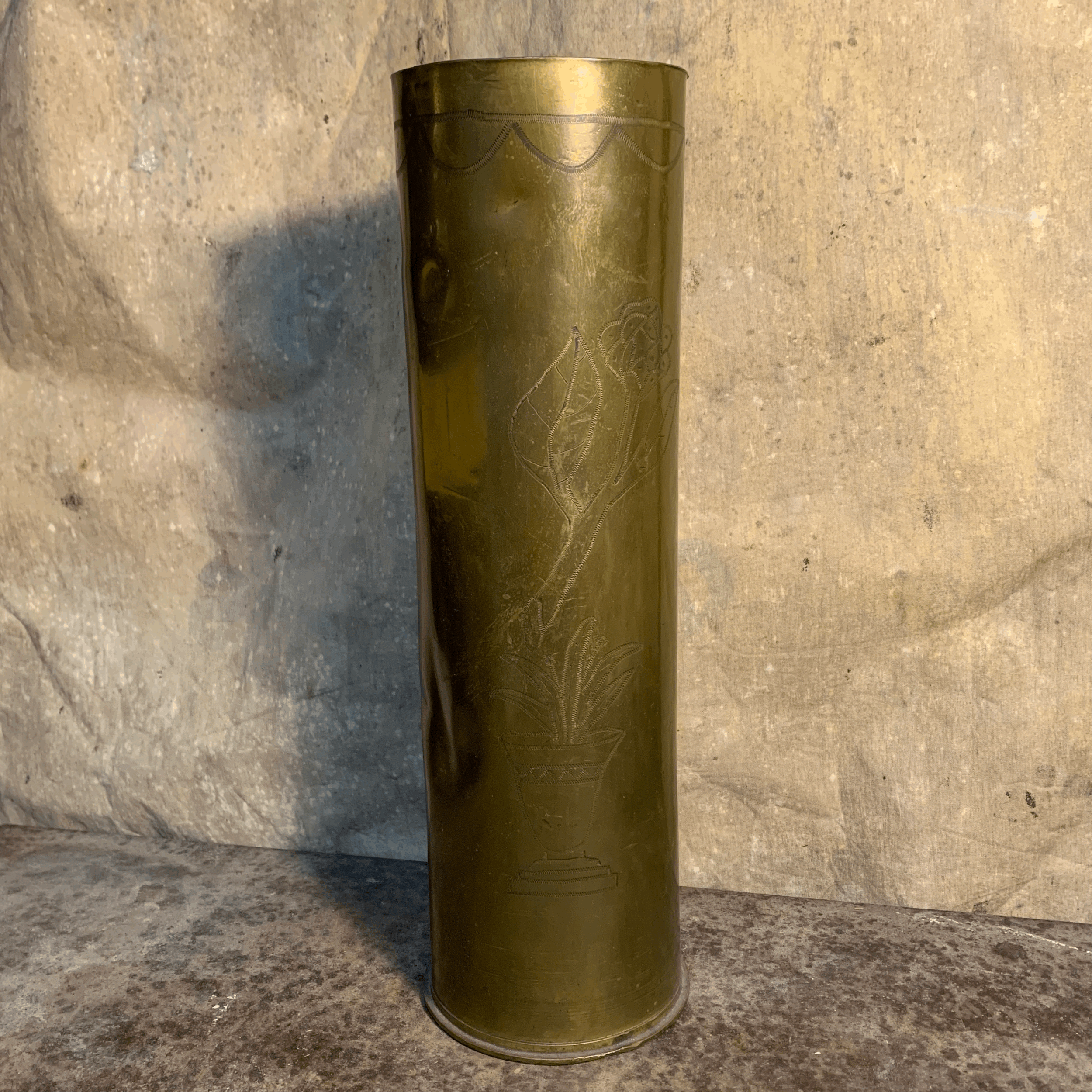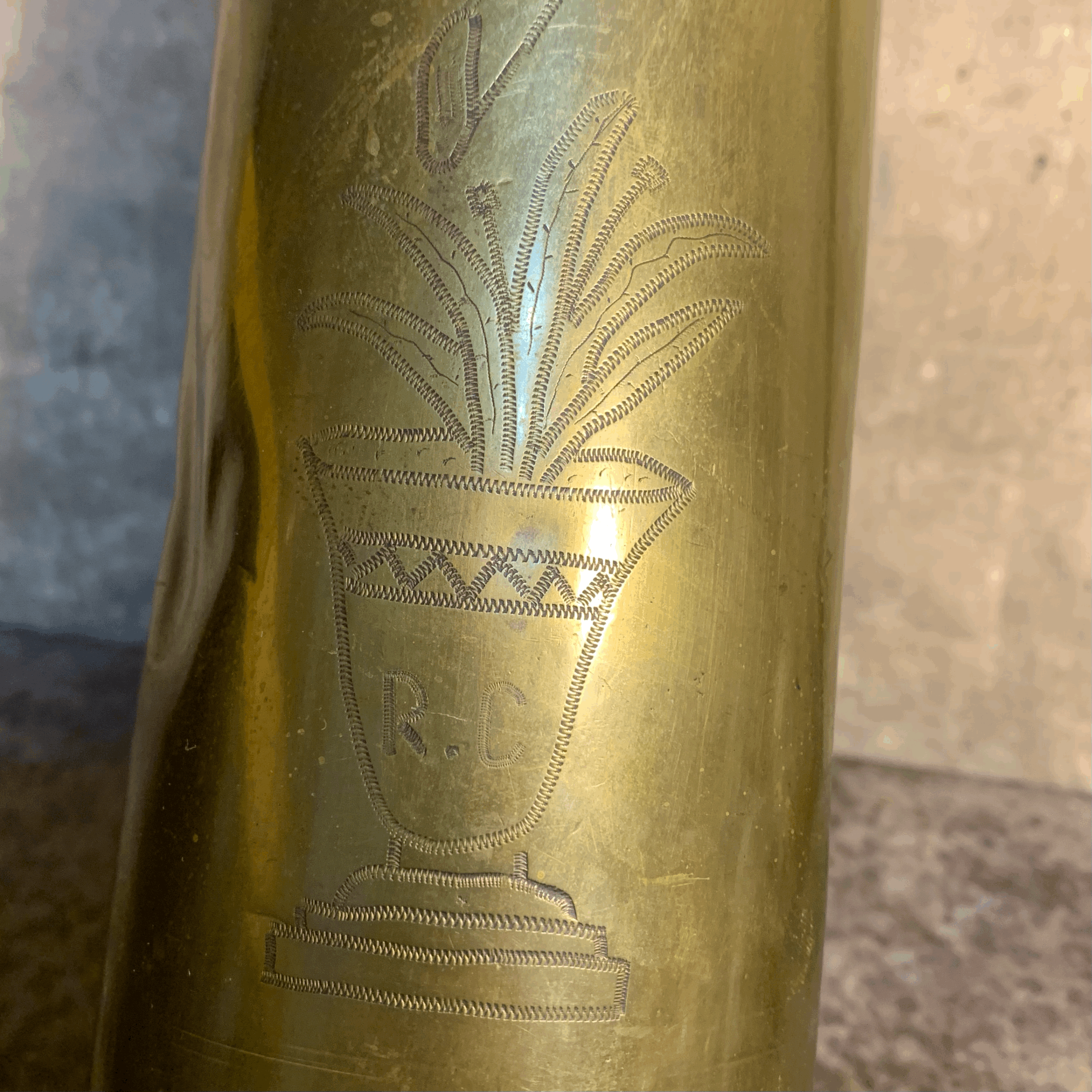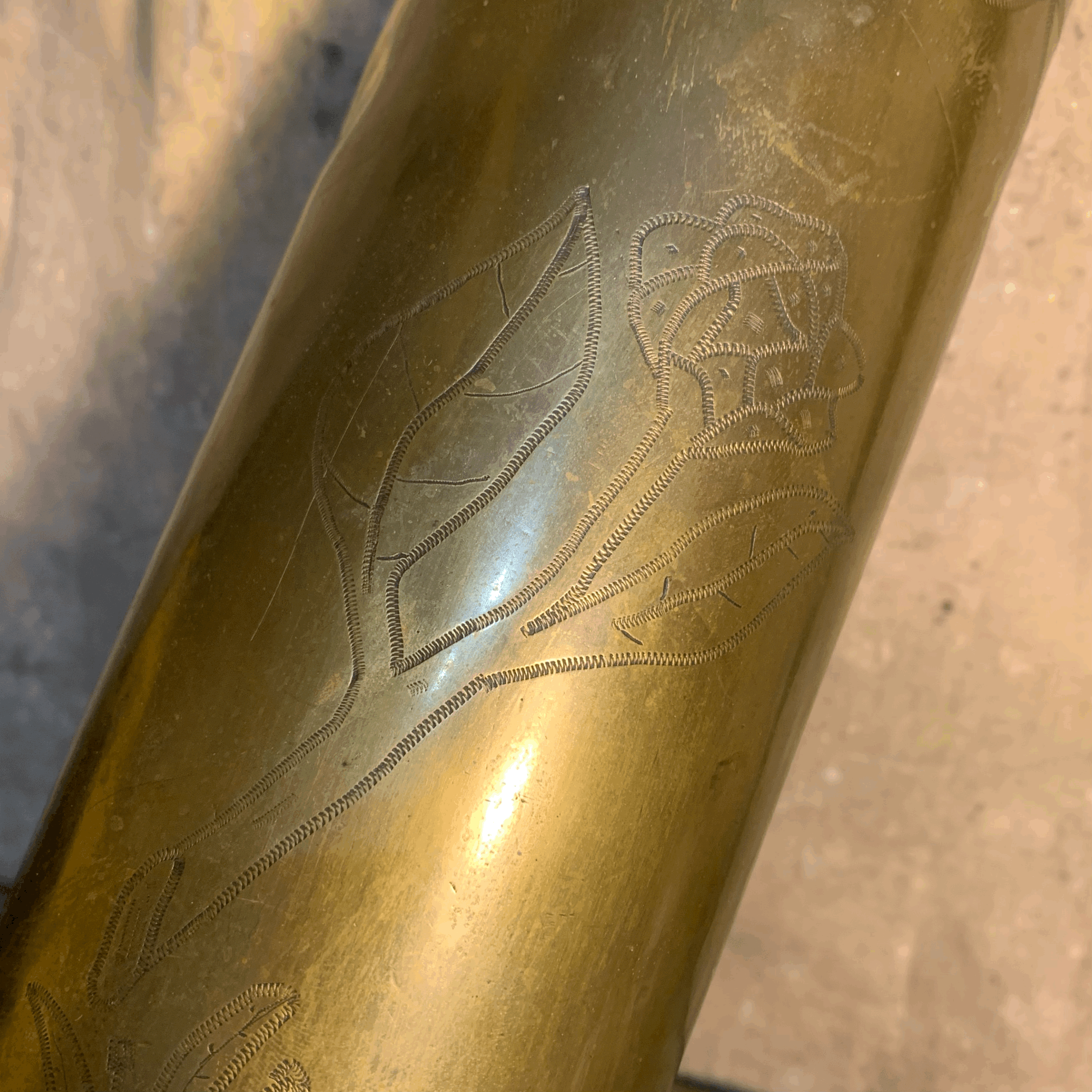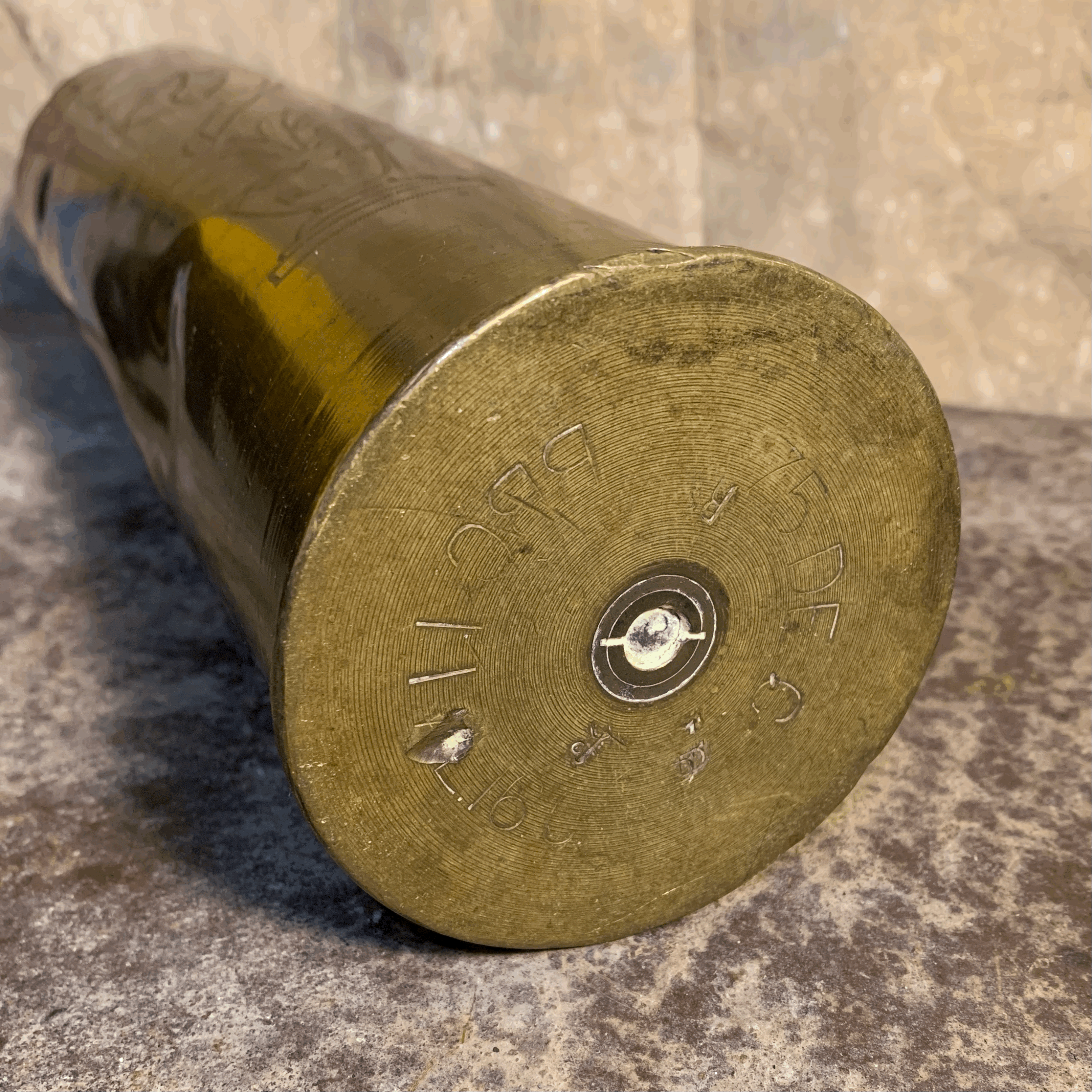 Image 1 of 4
Image 1 of 4

 Image 2 of 4
Image 2 of 4

 Image 3 of 4
Image 3 of 4

 Image 4 of 4
Image 4 of 4





Amateur Trench Art Shell
Since this will likely get absurd quickly lemme be real for a little bit first. I love trench art more than just about anything else. If you check out Worthpoint you can see me waxing about it with some moderation and editing. There will be neither of those things here. I love folk art. Even more I love when folk art has some sort of focus. A thing that is making said art happen. What crazier of thing is there than fucking war to focus efforts. So trench art is basically military folk art: usually spare artillery shells that are carved and manipulated to become take homes for soldiers. A lot of it wasn’t made by soldiers. Locals with more time and tools would take the spare materiel and make tourist items to sell to the soldiers essential. The range on these items is pretty dramatic, some are very basic and universal, freedom, go america, that sort of thing. But they can also get extremely specific and extremely personal. Names, faces, animals, places, comrades, all of that. Sentimental, risque, patriotic, everything. This range is one of the things I particularly love about trench art. It’s as if the range of human emotion and experience can be read in the shells. This particular example is mediocre but charming at the same time. The image is formed using maybe one stamp (other examples I’ve owned had master jeweler levels of stamp work in them) depicting a vase with a plant, and a flower, with some trim work around the edges. It’s not good. I have two conflicting opinions about this particular piece. It’s either a practice piece for someone just getting into the game. The proportions are weird, the scale is off, the placement is awkward, lots of unnecessary negative space, all that. Or, it’s a legit piece of trench art, made by a soldier who had never done this and was terrible at it. That’s certainly more charming to me, and why I kept this piece in the first place, but I can in no way confirm that, my provenance is weak on this example. But maybe more important is the thought behind this evaluation. Folk art is so funky to deal with, the way we evaluate it can be so finicky and at odds with (gross again fuck me) capital A Art. Motivation becomes so crucial to value and interest. I love trench art that was made by locals for soldiers to buy and take home. It’s beautiful and weird and interesting and has a very interesting Why? Why this piece, why this image, who were you buying it for, what were you thinking when you acquired it? This can invariably never be answered, which is a charming and frustrating aspect of this art. Also a dynamic that makes it more interesting to me. So much why and so few answers. Now on the other hand, if this was in fact made by a soldier in the trenches, more why? Boredom? Stress? What was the goal, what was the intent. When I get bored and stressed I go to my local bar and I write too many words about weird antiques. But my life is good and easy. What if I was several thousand miles away being forced to kill other children because nationalism allowed a crazy person to take over a country and enact rules and laws that led to violence and suffering and murder. What if I was good at physics in high school and wanted to be an electrical engineer but the system in place forced me to become part of the draft and now I run a radio out in the field in France in 1944 and I had a shitty family so I’m happy to be productive but I’ve seen humans explode feet away from me more than once. In the absolute best instances, this leads to art, what else good can come from these scenarios. No war, no death, no violence, no suffering will ever be worth art. Art is the best we have accomplished as a species but I will always hold that it is all worth destroying for any amount of human suffering. BUT, that is not a reasonable thing, so if we can extract a small amount of art from incalculable suffering, that is not nothing, and until that suffering can be eliminated, that art is viable for appreciation. In its truest form, trench art is an expression of that massive suffering but also an attempt to see anything else amongst that, to reach love, to reach beauty, to remember family. To remember that another life can exist, that a reality outside of suffering is possible. I by no means think that this is a fine piece of trench art, at best it is interesting. But all trench art gives me these thoughts, and even if the original owner, maker, purchaser, etc of this didn’t think as much as me about it, all these can be extracted from this mediocre vase. Not so mediocre maybe.
11"x3.5"
Since this will likely get absurd quickly lemme be real for a little bit first. I love trench art more than just about anything else. If you check out Worthpoint you can see me waxing about it with some moderation and editing. There will be neither of those things here. I love folk art. Even more I love when folk art has some sort of focus. A thing that is making said art happen. What crazier of thing is there than fucking war to focus efforts. So trench art is basically military folk art: usually spare artillery shells that are carved and manipulated to become take homes for soldiers. A lot of it wasn’t made by soldiers. Locals with more time and tools would take the spare materiel and make tourist items to sell to the soldiers essential. The range on these items is pretty dramatic, some are very basic and universal, freedom, go america, that sort of thing. But they can also get extremely specific and extremely personal. Names, faces, animals, places, comrades, all of that. Sentimental, risque, patriotic, everything. This range is one of the things I particularly love about trench art. It’s as if the range of human emotion and experience can be read in the shells. This particular example is mediocre but charming at the same time. The image is formed using maybe one stamp (other examples I’ve owned had master jeweler levels of stamp work in them) depicting a vase with a plant, and a flower, with some trim work around the edges. It’s not good. I have two conflicting opinions about this particular piece. It’s either a practice piece for someone just getting into the game. The proportions are weird, the scale is off, the placement is awkward, lots of unnecessary negative space, all that. Or, it’s a legit piece of trench art, made by a soldier who had never done this and was terrible at it. That’s certainly more charming to me, and why I kept this piece in the first place, but I can in no way confirm that, my provenance is weak on this example. But maybe more important is the thought behind this evaluation. Folk art is so funky to deal with, the way we evaluate it can be so finicky and at odds with (gross again fuck me) capital A Art. Motivation becomes so crucial to value and interest. I love trench art that was made by locals for soldiers to buy and take home. It’s beautiful and weird and interesting and has a very interesting Why? Why this piece, why this image, who were you buying it for, what were you thinking when you acquired it? This can invariably never be answered, which is a charming and frustrating aspect of this art. Also a dynamic that makes it more interesting to me. So much why and so few answers. Now on the other hand, if this was in fact made by a soldier in the trenches, more why? Boredom? Stress? What was the goal, what was the intent. When I get bored and stressed I go to my local bar and I write too many words about weird antiques. But my life is good and easy. What if I was several thousand miles away being forced to kill other children because nationalism allowed a crazy person to take over a country and enact rules and laws that led to violence and suffering and murder. What if I was good at physics in high school and wanted to be an electrical engineer but the system in place forced me to become part of the draft and now I run a radio out in the field in France in 1944 and I had a shitty family so I’m happy to be productive but I’ve seen humans explode feet away from me more than once. In the absolute best instances, this leads to art, what else good can come from these scenarios. No war, no death, no violence, no suffering will ever be worth art. Art is the best we have accomplished as a species but I will always hold that it is all worth destroying for any amount of human suffering. BUT, that is not a reasonable thing, so if we can extract a small amount of art from incalculable suffering, that is not nothing, and until that suffering can be eliminated, that art is viable for appreciation. In its truest form, trench art is an expression of that massive suffering but also an attempt to see anything else amongst that, to reach love, to reach beauty, to remember family. To remember that another life can exist, that a reality outside of suffering is possible. I by no means think that this is a fine piece of trench art, at best it is interesting. But all trench art gives me these thoughts, and even if the original owner, maker, purchaser, etc of this didn’t think as much as me about it, all these can be extracted from this mediocre vase. Not so mediocre maybe.
11"x3.5"
Since this will likely get absurd quickly lemme be real for a little bit first. I love trench art more than just about anything else. If you check out Worthpoint you can see me waxing about it with some moderation and editing. There will be neither of those things here. I love folk art. Even more I love when folk art has some sort of focus. A thing that is making said art happen. What crazier of thing is there than fucking war to focus efforts. So trench art is basically military folk art: usually spare artillery shells that are carved and manipulated to become take homes for soldiers. A lot of it wasn’t made by soldiers. Locals with more time and tools would take the spare materiel and make tourist items to sell to the soldiers essential. The range on these items is pretty dramatic, some are very basic and universal, freedom, go america, that sort of thing. But they can also get extremely specific and extremely personal. Names, faces, animals, places, comrades, all of that. Sentimental, risque, patriotic, everything. This range is one of the things I particularly love about trench art. It’s as if the range of human emotion and experience can be read in the shells. This particular example is mediocre but charming at the same time. The image is formed using maybe one stamp (other examples I’ve owned had master jeweler levels of stamp work in them) depicting a vase with a plant, and a flower, with some trim work around the edges. It’s not good. I have two conflicting opinions about this particular piece. It’s either a practice piece for someone just getting into the game. The proportions are weird, the scale is off, the placement is awkward, lots of unnecessary negative space, all that. Or, it’s a legit piece of trench art, made by a soldier who had never done this and was terrible at it. That’s certainly more charming to me, and why I kept this piece in the first place, but I can in no way confirm that, my provenance is weak on this example. But maybe more important is the thought behind this evaluation. Folk art is so funky to deal with, the way we evaluate it can be so finicky and at odds with (gross again fuck me) capital A Art. Motivation becomes so crucial to value and interest. I love trench art that was made by locals for soldiers to buy and take home. It’s beautiful and weird and interesting and has a very interesting Why? Why this piece, why this image, who were you buying it for, what were you thinking when you acquired it? This can invariably never be answered, which is a charming and frustrating aspect of this art. Also a dynamic that makes it more interesting to me. So much why and so few answers. Now on the other hand, if this was in fact made by a soldier in the trenches, more why? Boredom? Stress? What was the goal, what was the intent. When I get bored and stressed I go to my local bar and I write too many words about weird antiques. But my life is good and easy. What if I was several thousand miles away being forced to kill other children because nationalism allowed a crazy person to take over a country and enact rules and laws that led to violence and suffering and murder. What if I was good at physics in high school and wanted to be an electrical engineer but the system in place forced me to become part of the draft and now I run a radio out in the field in France in 1944 and I had a shitty family so I’m happy to be productive but I’ve seen humans explode feet away from me more than once. In the absolute best instances, this leads to art, what else good can come from these scenarios. No war, no death, no violence, no suffering will ever be worth art. Art is the best we have accomplished as a species but I will always hold that it is all worth destroying for any amount of human suffering. BUT, that is not a reasonable thing, so if we can extract a small amount of art from incalculable suffering, that is not nothing, and until that suffering can be eliminated, that art is viable for appreciation. In its truest form, trench art is an expression of that massive suffering but also an attempt to see anything else amongst that, to reach love, to reach beauty, to remember family. To remember that another life can exist, that a reality outside of suffering is possible. I by no means think that this is a fine piece of trench art, at best it is interesting. But all trench art gives me these thoughts, and even if the original owner, maker, purchaser, etc of this didn’t think as much as me about it, all these can be extracted from this mediocre vase. Not so mediocre maybe.
11"x3.5"